The following is a summary of global temperature conditions in Berkeley Earth’s analysis of March 2023.
- Globally, March 2023 was abruptly warmer than February and tied for the 2nd warmest March since records began in 1850.
- March global average temperatures exceeded 1.5 °C (2.7 °F) above the 1850 to 1900 baseline, becoming the 10th time this has occurred for a monthly average.
- On land, March 2023 was the 2nd warmest March since 1850.
- Warm conditions occurred in much of Asia, parts of Europe and North Africa, the Arctic, southern South America, and several oceanic regions.
- Unusually cool conditions were present in parts of the Western United States and Canada, as well as much of the Southern Pacific.
- The Pacific exhibits neutral conditions with a transition to El Niño considered likely later this year.
- 2023 is on pace to be the 2nd, 3rd, or 4th warmest year, but considerable uncertainty remains, including a substantial 38% likelihood that 2023 could become a new record warm year.
Global Summary
Globally, March 2023 has been nominally the second warmest March since records began in 1850. This March was warmer than the previous two years, but still cooler than the recent record warm March in 2016. Given the uncertainties, March 2023 is effectively tied with the March averages in 2017, 2019, and 2020, and any these could reasonably be described as the second warmest March. March 2023 was distinctly warmer than any March prior to 2016.

The global mean temperature in March 2023 was 1.52 ± 0.10 °C (2.74 ± 0.18 °F) above the 1850 to 1900 average, which is frequently used as a benchmark for the preindustrial period. The global mean temperature anomaly in March 2023 exhibited a sharp increase in temperature relative to February 2023, rising more than 0.2 °C (0.36 °F). This was driven by sharp warming on land, 0.4 °C (0.72 °F), and moderate warming in the oceans, 0.1 °C (0.18 °F). Such large month-to-month shifts are uncommon, but not unheard of, occurring approximately 5% of the time.
March 2023 was also the warmest month since 2020, and the 10th individual month in the Berkeley Earth analysis to have exceeded 1.5 °C above the 1850 to 1900 average. Through international agreements, countries have set a goal to keep the average level of global warming below 1.5 °C. That target level of 1.5 °C is fast approaching, as evidenced by individual months now occasionally exceeding 1.5 °C, but would not be considered to have been breached until the average temperature over several years has exceeded 1.5 °C of warming.
Temperatures in March were noticeably above the long-term trend line, but would still be consistent with natural variability within the ongoing pattern of global warming.
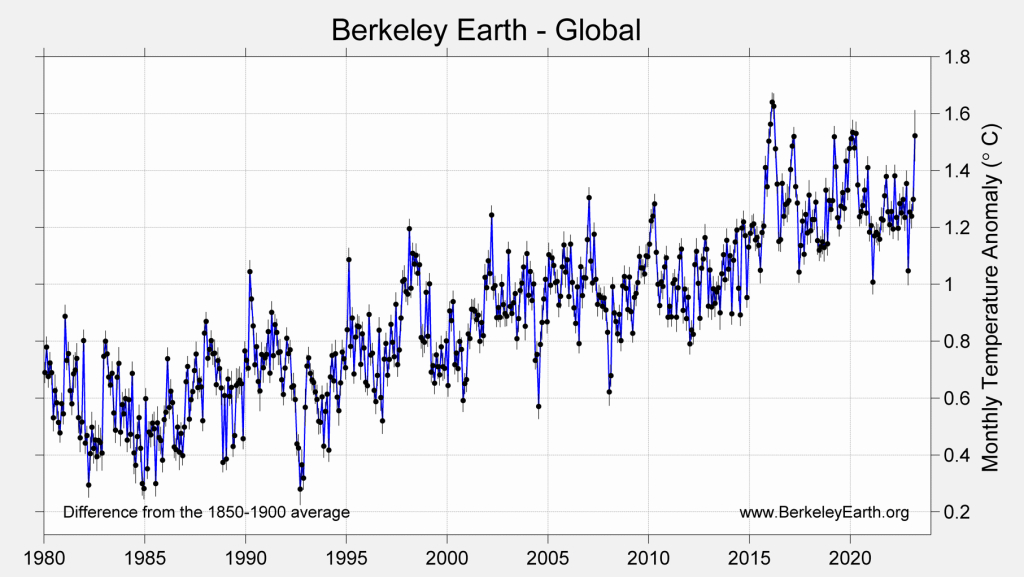
Spatial Variation
March 2023 continues the ongoing pattern of widespread warmth, though with a few exceptions. Particularly warm conditions were present in most of Asia, parts of Europe and North Africa, some of the Arctic, southern South America, and various oceanic areas. Though the warmth across Asia is pronounced, this region is highly variable at this time of year, and only a few areas set new records.
Particularly cool conditions were present in the Western USA and parts of Canada, as well as parts of the Southern Pacific. Amid unusually heavy rainfall and snow, a small part of California recorded their second coldest March on record.
We estimate that 3.4% of the Earth’s surface experienced their locally warmest March average, and 82% of the Earth’s surface was significantly warm when compared to their local average during the period 1951 to 1980. In addition, no part of the Earth’s surface had their locally coldest March.
The cool area associated with La Niña that had previously existed in the eastern Equatorial Pacific has now entirely dissipated. La Niña conditions are considered to have ended in February. The Pacific Ocean is now in a neutral or transitional phase, with a transition towards El Niño considered likely later in 2023.
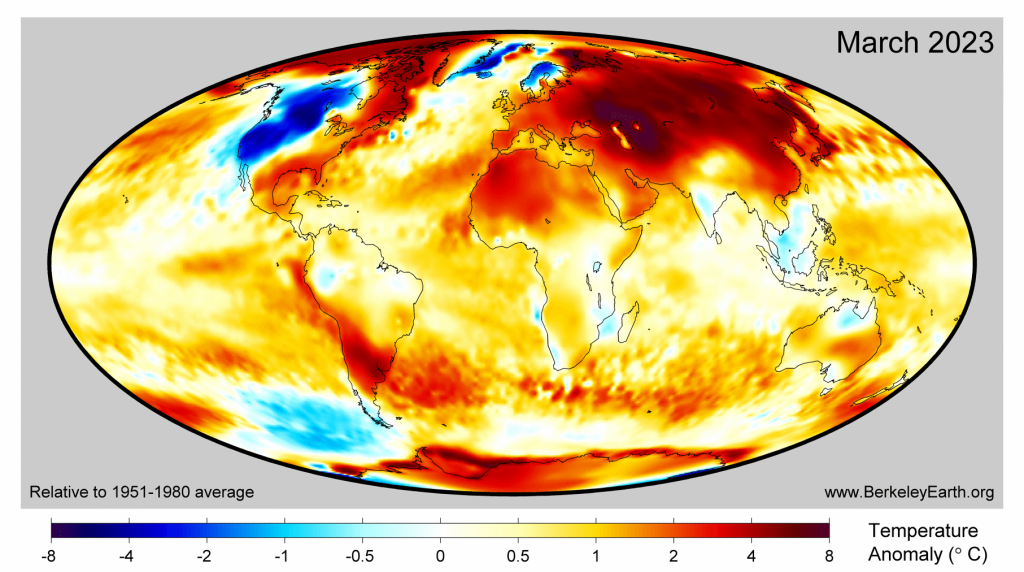
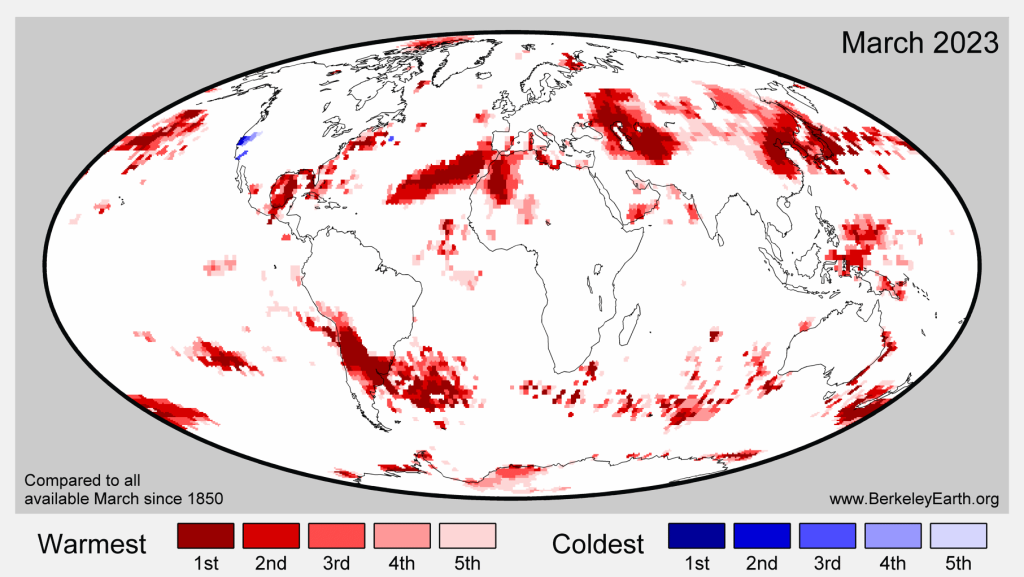
Over land regions, 2023 was the 2nd warmest March ever observed. The land average was 2.35 ± 0.13 °C (4.23 ± 0.23 °F) above the 1850 to 1900 average. Only March 2016 was warmer on land.
March 2023 was the 4th warmest March in the oceans, recorded as 0.96 ± 0.13 °C (1.73 ± 0.23 °F) above the 1850 to 1900 average. This is significantly warmer than the previous two La Niña years, though still cooler than the peaks in 2016 and 2020.
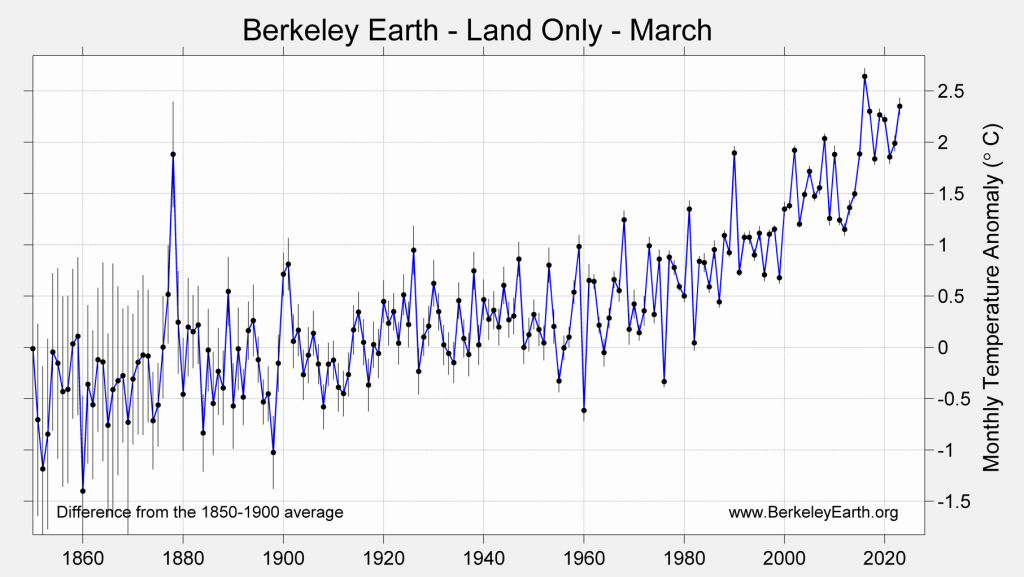
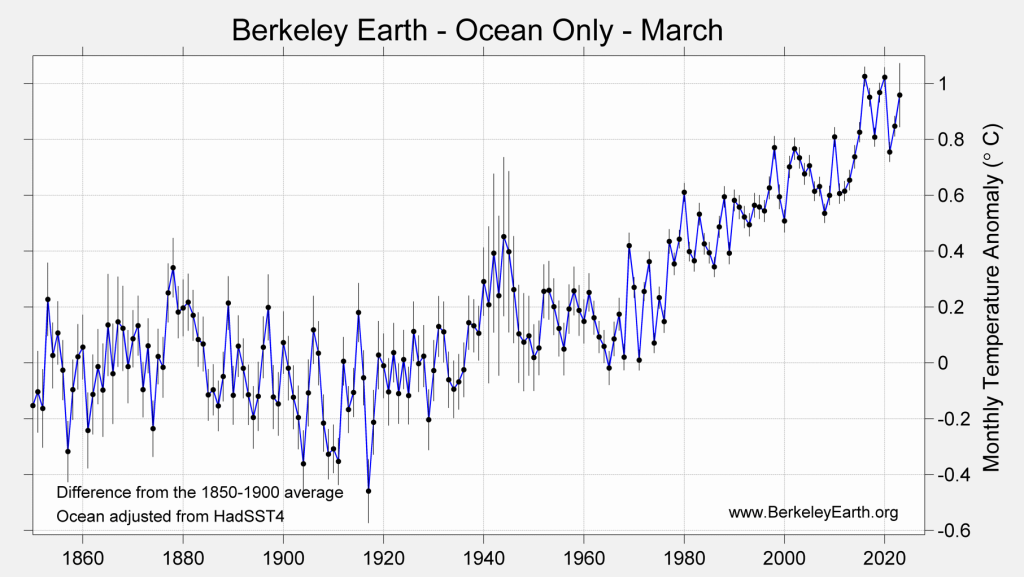
El Niño Outlook
March 2023 exhibits a neutral condition in the Pacific Ocean with a trend towards El Niño. The now ended La Niña event began in 2020 and had exhibited unusual longevity, and contributed to relatively cooler global average temperatures during the last two years. The current CPC/IRI analysis suggests that neutral conditions will persist for at least a few months, followed by a 60% chance of a shift to El Niño conditions during the middle or end of 2023. Models currently disagree on the intensity of the possible El Niño, with some models predicting a very strong event, while others are more moderate. The developing warm pool in the Pacific will likely give us a clearer idea of what to expect within a few months.
If El Niño develops, it is likely to moderately boost global average temperatures during the rest of 2023 and into 2024. Due to the lag between the development of El Niño and its full impact being felt on global temperatures, it is likely that any El Niño will have a greater impact on 2024 global temperatures than it does on 2023.
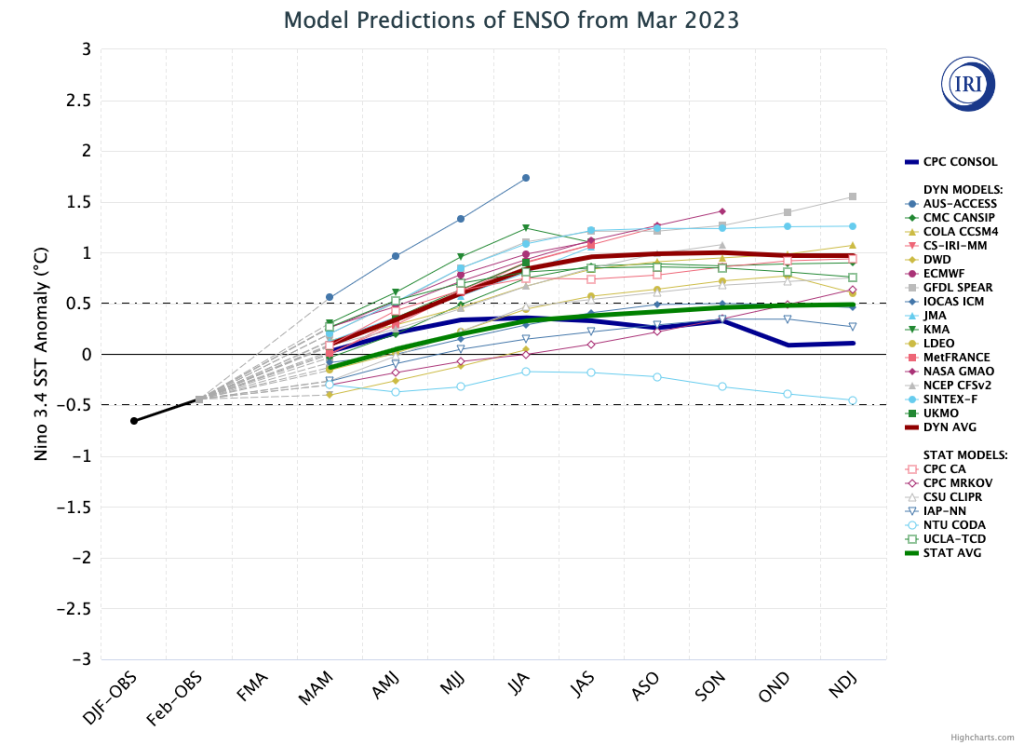
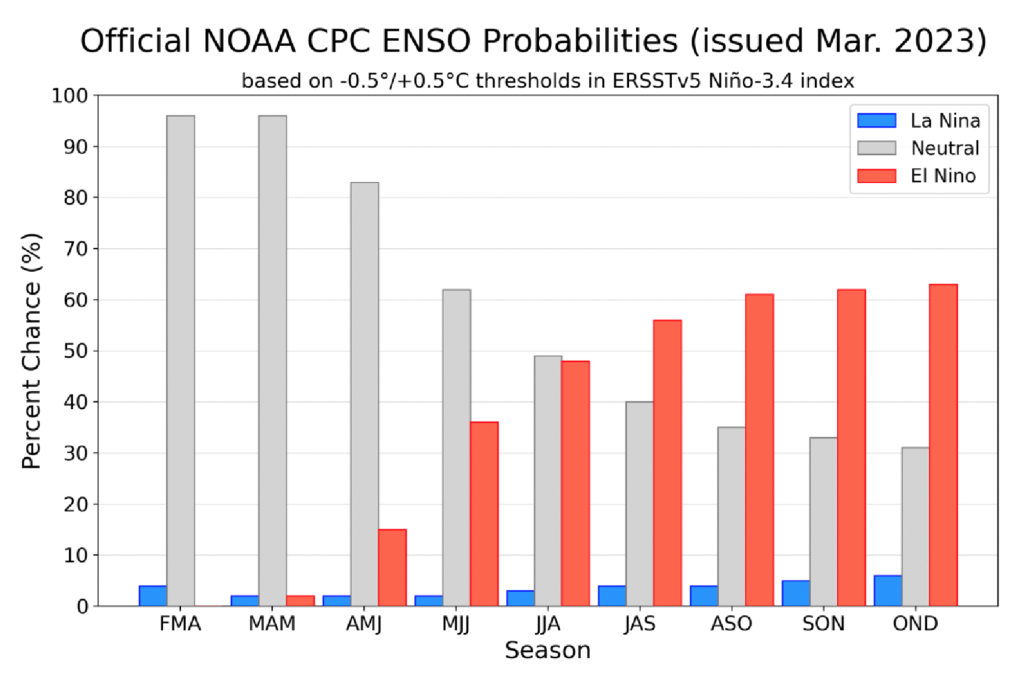
Year to Date
This year began with a January that was similar to January in 2021 and 2022. However, with the end of La Niña, temperatures have diverged markedly in February and March, and considerably warmer than in 2021 or 2022. In fact, global mean temperature in March 2023 was much more similar to the El Niño boosted temperatures observed in March 2016 and 2020.
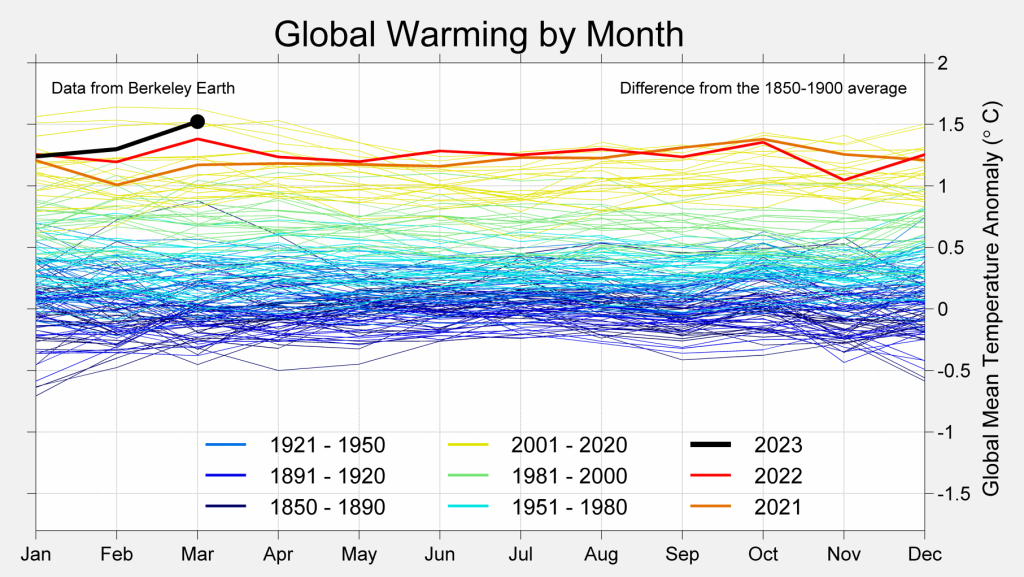
The most significant spatial features of year-to-date temperatures are the end of La Niña, warmth across much of the northern mid-latitudes, and several ocean hotspots. Year-to-date, 3.9% of the Earth’s surface has experienced average temperatures that are a local record high. In addition, 0.01% of the surface has been record cold year-to-date.

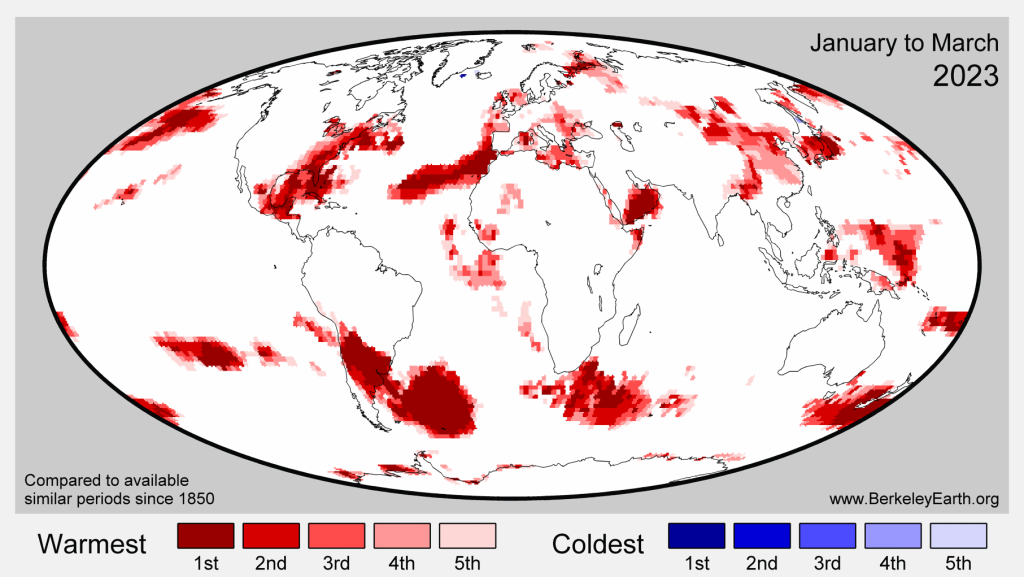
Rest of 2023
Year-to-date temperatures currently place 2023 as the 3rd warmest year, but with considerably uncertainty for the rest of 2023. The surprisingly strong warming in March 2023, combined with an increased likelihood of a strong El Niño event, have increased the forecast for the rest of 2023. The statistical approach that we use, looking at conditions in recent months, believes that 2023 is likely to be the 2nd, 3rd, or 4th warmest year in the instrumental record (53% likelihood)
However, we now estimate a 38% chance that 2023 will warm sufficiently to become a new record warm year (i.e. roughly 2 chances out of 5). This is a sharp increase from our previous estimate of 18% at the end of February. The possibility of a new record is likely dependent on a strong El Niño developing.
Even in the presence of a strong El Niño, 2023 as a whole would still be unlikely to exceed 1.5 °C (2.7 °F) above the preindustrial benchmark. Though the projections have shifted towards the upper end, it remains somewhat more likely than not that 2023 remains slightly less than a record, e.g. the 2nd, 3rd, or 4th warmest year.
Absent an enormous volcanic eruption, or other exceptional intervening event, it is near certain that 2023 will become one of the top seven warmest years.
Because of the lag between the development of an El Niño and its maximum impact on global temperatures, an El Niño that develops during 2023 is likely to have an even larger impact on global mean temperature in 2024 than 2023.

Likelihood of final 2023 ranking:
- 1st place (38 %)
- 2nd or 3rd place (22 %)
- 4th place (31 %)
- 5th place (5 %)
- 6th place (2 %)
- 7th place (1 %)
- Top 7 overall (> 99 %)
Methodology
The Berkeley Earth global temperature data set is ordinarily a combination of Berkeley Earth land surface temperature data and an interpolated ocean sea surface temperature field derived from the HadSST4 data set. The HadSST data set is built upon multiple third-party data collections of direct ocean temperature measurements from ships, buoys, and other platforms. During most of 2021 and 2022, HadSST updates were frequently subject to delays of weeks or months due to delays in the third-party data sources that it relied on. Due to these delays, Berkeley Earth updates were also frequently delayed.
Due to the ongoing delays, we have prepared this monthly temperature report using an alternative set of sea surface temperature data. The data set adopted for this purpose is the sea surface temperature data from the Copernicus ERA5 reanalysis. This alternative data is only used for March 2023 during which HadSST4 is not yet available. The ERA5 data has been reprocessed to make it more similar to the resolution of our previous analysis and local anomaly baselines have adjusted to match the 1980 to 2021 period in HadSST4.
We believe that this substitute data should provide a good indication of current global ocean conditions.
However, due to difference between ERA5 and HadSST4, we do observe more small-scale variation in the data processed this way and estimates of temperature ranks for assessing local records may sometimes be unreliable in the ocean. In addition, we have increased the reported uncertainty on the ocean averages to include an estimate of the systematic differences between HadSST4 and ERA5.
Though we have adopted ERA5 ocean data for these reports in order to provide timely temperature updates, the gridded data sets appearing on the Berkeley Earth website will continue to use only HadSST as described in the associated documentation. As a result, updates to some of the gridded data sets are likely to continue to be delayed.

